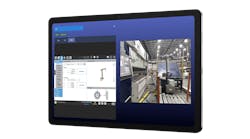When automation professionals hear the phrase “distributed control system” or its acronym DCS, they usually think about the huge, monolithic and expensive control systems often used in big process plants. Ironically, most distributed control systems in process plants don’t distribute control at all, but instead consolidate it into a few centralized processors.
But, when it comes to machine automation, distributed control means something else entirely. In this case, distributed control means taking a real-time control or data processing task away from the main controller and distributing it to one or more cabinet- or field-mounted controllers. The main reasons for using distributed control are to perform specialized tasks, add redundancy, improve performance and simplify programming.
Figure: Machines such as this metal press often require extensive control of hydraulic motion, a task better performed by a distributed controller than by the main PLC or PAC.
(Source: Delta Computer Systems)
Distributed controllers can be used to perform tasks not easily handled by the main controller, particularly if the main controller is a PLC, as opposed to a more powerful PAC. Safety-rated distributed controllers are perhaps the most widespread use of distributed controllers.
Instead of upgrading the main controller to a very expensive safety-rated PLC or PAC to handle hundreds of standard and a few safety I/O points, it’s often much more cost-effective to simply add a safety-rated controller to handle the safety I/O. The distributed safety-rated controller can be a simple smart relay if there are just a few points of safety I/O or a small safety-rated PLC to handle more I/O. In either case, savings can be significant as compared to using a safety-rated main controller with its hundreds of I/O points.
Another specialized task often handled by distributed controllers is motion control. Although many PLCs and PACs can in theory be programmed to control motion, it’s often more cost-effective to use one or more motion controllers to perform this custom control activity, instead of trying to make the main controller do something a bit outside its main realm of capability.
RELATED CASE STUDY: Field logic controller solves a clean-in-place application
Hydraulic motion control is a good example of a task that could in theory be handled by a main controller but is often instead best addressed with a specialized distributed controller. “Our motion controllers are capable of optimizing machine functionality via precise closed-loop control of hydraulic and electric servo position, velocity, pressure/force or torque, enabling the main controller to concentrate on other functions,” says Bill Savela, director of marketing at Delta Computer Systems.
“If the main controller, such as a PLC, were to perform the motion control function in addition to other functions, the system would likely not be able to achieve as high a degree of motion precision and/or axis synchronization. This is in part because a main controller must divide its time among many diverse tasks and may not be able to close the control loop associated with any one specific control function fast enough,” adds Savela.
“Our controllers can also perform custom processing of sensor feedback. If multiple sensors are highly sensitive to different ranges of inputs, switching among them can extend the range of feedback sensitivity incorporated into the control loop. Mathematical operations can also be performed on sensor data before it is incorporated into the control loop. This enables the motion controller to perform precise control even when the sensor responds to field conditions in a nonlinear manner. These capabilities expand on the power of the distributed controller, enabling greater precision and/or reliability, and offloading the main controller,” concludes Savela.
Another specialized task is data acquisition and processing for sensors and other input points not needed for real-time control. Although it’s possible to wire all of these points back to the main controller, it’s often not cost-effective, particularly for retrofits where new sensors are being added. Although this is not strictly distributed control as real-time control is not being performed, it is an important part of the automation system, and some control functions are usually required to manage and massage the sensor data.
“One major influence of the Industrial Internet of Things (IIoT) is the rapid addition of sensors to various machines,” says Mark Lochhaas, product sales manager at Advantech. “Many end users are recognizing the need to sense virtually every operating parameter and bring corresponding data to the cloud, but this requires a component between the sensor and the cloud. There are various layers of data collection, concentration, pre-storage analysis and communication; and distributed control in the form of intelligent remote I/O can be used to encompass these layers by performing the data-acquisition corresponding tasks.”
In the future, sensors will be used more widely and become more intelligent, probably moving from hardwired connections and industrial protocols to more IT-friendly protocols such as message queuing telemetry transport (MQTT), a publish/subscribe, extremely simple and lightweight messaging protocol designed for constrained devices and low-bandwidth, high-latency or unreliable networks. “Remote I/O and other edge computing platforms will become smaller and more powerful with enhanced communication capability yet consume less power. Software development will allow collaboration among devices and platforms for significantly more sophisticated distributed control. Centralized control will always be necessary, but it will become more supervisory,” believes Lochhaas.
“One of the benefits of using a distributed controller in place of a standard I/O device is that the distributed controller can back up the main controller if it goes down, and take over and safely shut down the process,” says Noah Glenn, product manager for fieldbus technology at Turck (www.turck.us). Another benefit is offloading the main controller from tasks that can consume a significant amount of processing power. And, because control is local, it can often be much faster than with simple remote I/O, which must communicate back and forth with the main controller.
“Distributed controllers can be used to enable localized, flexible distributed machine control in applications such as conveying and other material handling systems,” adds Glenn. “Other possible control applications are those in which things have to happen in a certain order such as those utilizing RFID, grippers, die protection, recipes, motor speed, counting, light curtains and other components and functions.”
Distributed controllers can be programmed in a variety of ways. Some are programmed with PC-based software using ladder logic and other IEC-61131 languages such as flow charts or scripting.
Whether they are called distributed controllers, smart remote I/O or specialized controllers, these components can be used to design better automation systems. Trends such as the IIoT often require the addition of sensors, and it’s often more cost-effective to handle these added input points with distributed control. Increased emphasis on safety along with new regulations often require the addition of safety-rated I/O, another task often best handled by distributed control.
Dan Hebert is a contributing editor for Control and Control Design. Reach him at [email protected].






